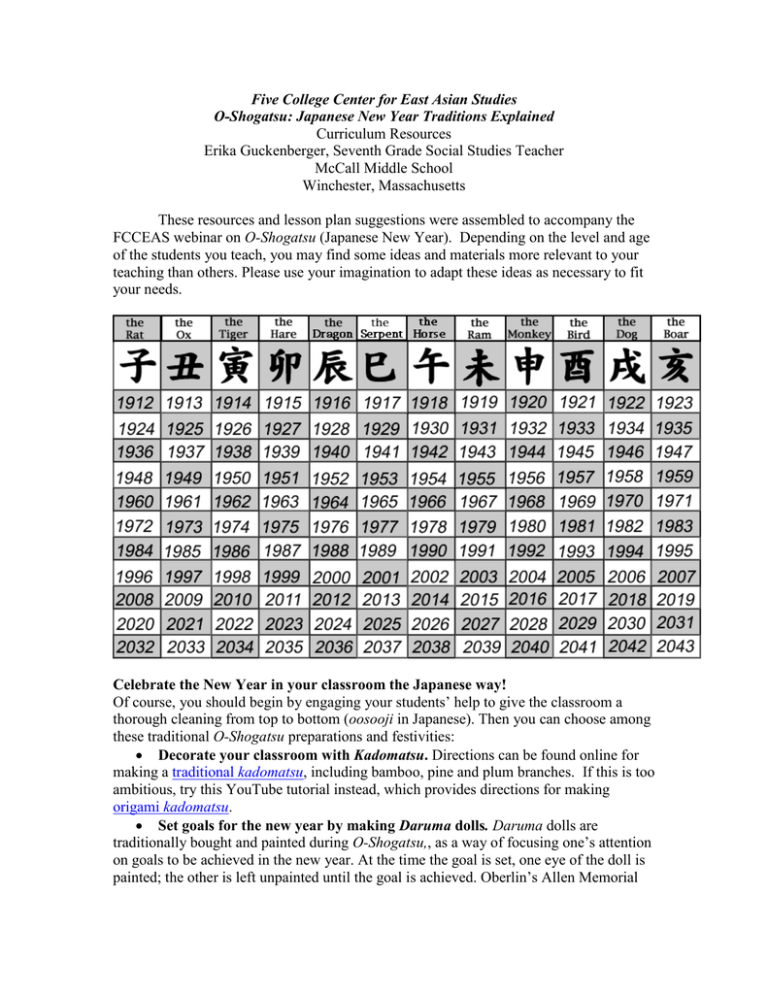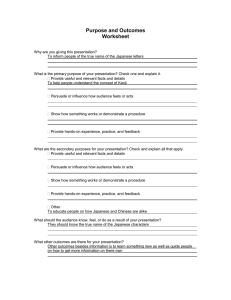O-Shogatsu Teaching Resources
advertisement

Five College Center for East Asian Studies O-Shogatsu: Japanese New Year Traditions Explained Curriculum Resources Erika Guckenberger, Seventh Grade Social Studies Teacher McCall Middle School Winchester, Massachusetts These resources and lesson plan suggestions were assembled to accompany the FCCEAS webinar on O-Shogatsu (Japanese New Year). Depending on the level and age of the students you teach, you may find some ideas and materials more relevant to your teaching than others. Please use your imagination to adapt these ideas as necessary to fit your needs. Celebrate the New Year in your classroom the Japanese way! Of course, you should begin by engaging your students’ help to give the classroom a thorough cleaning from top to bottom (oosooji in Japanese). Then you can choose among these traditional O-Shogatsu preparations and festivities: Decorate your classroom with Kadomatsu. Directions can be found online for making a traditional kadomatsu, including bamboo, pine and plum branches. If this is too ambitious, try this YouTube tutorial instead, which provides directions for making origami kadomatsu. Set goals for the new year by making Daruma dolls. Daruma dolls are traditionally bought and painted during O-Shogatsu,, as a way of focusing one’s attention on goals to be achieved in the new year. At the time the goal is set, one eye of the doll is painted; the other is left unpainted until the goal is achieved. Oberlin’s Allen Memorial Art Museum has posted a lesson plan for teaching about the daruma tradition and making daruma dolls with students. The lesson plan includes directions for both paper and “model magic” versions. YouTube also has directions for making origami daruma, as well as a video about the way that traditional daruma are crafted in Japan. Make ema containing wishes for the new year. Ema are votive plaques that can be purchased at Shinto shrines year-round, but they are particularly popular during the hatsumode, the first shrine visit of the new year. Students can make their own ema out of paper, cardboard or scrap wood, writing their wishes on the back and decorating the front with good luck symbols, auspicious kanji, or drawings of the zodiac animal of the upcoming year (see chart above). This lesson plan from UCLA’s Fowler Museum introduces students to the history of the ema tradition, and instructions for using poetry to convey one’s ema wishes. Learn the O-Shogatsu song. The East Asia Program at Cornell has developed a lesson plan on Japanese New Year’s, (note: click on “New Year’s Celebrations”) which contains the O-Shogatsu song lyrics. There is also a YouTube video (with images from My Neighbor Totoro) to teach you the tune. Play the game Fukuwarai. This game is commonly played by children at New Year’s. It is similar to “Pin the Tail on the Donkey,” but the blindfolded player has to place the features (eyes, nose, mouth, etc.) onto the outline of a face. This website contains directions as well as a template for the pieces, although you could just draw your own pieces on posterboard, cut them out and laminate them. Make Nengajo. Have students make nengajo for their classmates; perhaps they can work on them for several weeks in December, place them in a mailbox in the classroom, and look forward to delivery on the first school day after the new year. The Japan Forum website contains a detailed article about the nengajo tradition, and includes annotated diagrams of traditional card design, as well as the kanji for writing greetings in Japanese. (Note that this website refers to the “New Year” as being 1999, or the Year of the Rat; for the zodiac symbols of upcoming years, see the chart above.) Older students, especially those studying Japanese, might want to take part in the Japanese Embassy’s yearly nengajo design contest. Eat traditional O-Shogatsu foods. It might be difficult (and expensive) to obtain traditional osechi-ryori, but mochi and soba can be more easily obtained, especially if you have access to a Japanese grocery store. Mochi can be bought ready to eat, or if you are ambitious, you can make your own. There are numerous simple soba recipes available online; just remember that traditionally, soba noodles are eaten after the temple bell rings 108 times. (Click here for a video of the bell-ringing at Chion-in Temple in Kyoto). If bringing food into the classroom is too difficult, YouTube also has videos which illustrate the traditional mochi pounding technique and the way that chefs make soba noodles by hand. Make origami representing the zodiac animals and other O-Shogatsu symbols. See above for links to video tutorials for making origami kadomatsu and daruma dolls; YouTube also has instructions for an origami ema and an origami hagoita (badminton racquet). Origami Resource Center lists various patterns for making the animals of the Chinese/ Japanese zodiac. Read a folktale connected to O-Shogatsu. The most famous is the story about an elderly man who is unable to afford New Year’s mochi for himself and his wife, until the Jizo statues he has generously outfitted with new hats come to life and arrive in the middle of the night laden with gifts. Bamboo Hats and a Rice Cake by Ann Tompert is a beautifully illustrated version of this tale, which also provides a Japanese language lesson by introducing the kanji for various words. Another version of the same tale, called “The Grateful Statues,” can be found in Japanese Children’s Favorite Stories by Florence Sakade (the book comes along with a CD of audio recordings of the stories.) Those who are familiar with kamishibai might be interested in the kamishibai version of the story, called Hats for the Jizos. Another kamishibai, How the Years Were Named, tells the story of the origin of the Japanese zodiac. Both can be purchased at the Kamishibai for Kids website, and come along with teachers’ guides. (For more kamishibai-related teaching ideas, see below). Learn about the traditional Japanese card game, Karuta. Karuta, also called Uta Garuta and Hyakunin Isshu, is a card game in one person reads the first lines of a tanka poem, and players compete to find the card which contains the poem’s final lines. This game has traditionally been played in Japan to celebrate both O-Shogatsu and hanami (cherry blossom watching). Teachers may want to share this excellent essay about karuta with their students; meanwhile, this article from Kids’ Web Japan explains the game’s resurgence in popularity among the new generation. Sets of karuta cards in Japanese can be purchased online (search on ebay for “hyakunin isshu”), although English versions are uncommon. If you are ambitious, you might make your own English version of the game; this lesson plan has instructions to make a version using Japanese proverbs rather than poems, although it is missing the list of the proverbs to use. This list might serve as a satisfactory substitute. Use O-Shogatsu as a lead-in to a unit on Japanese folktales. See above for the titles of some Japanese folktales related to Japanese New Year. The Peabody Essex Museum has developed a lesson plan centered on the kamishibai play Hats for the Jizos; this lesson uses the folktale to give primary grade students an introduction to Buddhism in Japan. The lesson also includes instructions for students to make their own kamishibai. Teacher Julie Rosenoff has posted further instructions and resources for making kamishibai with students, including a diagram which illustrates the proper layout of text and pictures on the front and back of the cards. For a tutorial on the history of kamishibai, historical photos of kamishibai readings, and an example of a kamishibai project made by a student, see the online book created by Jennifer Tighe. Finally, the Institute of Texan Cultures has posted a lesson plan in which students rewrite a Japanese folktale in a kamishibai format; their list of suggested Japanese folktales, including authors and publishing information, is particularly useful. Use O-Shogatsu as means of teaching the Japanese language. See above for resources to teach students to write nengajo, traditional Japanese New Year’s Cards. Students might also make O-Shogatsu banners containing kanji or hiragana greetings; the Japan Forum page about nengajo contains some sample messages that could be used. In addition, the children’s book Bamboo Hats and a Rice Cake by Ann Tompert can be used to teach students the kanji for various words, as well as expose them to a traditional O-Shogatsu folktale. Finally, as discussed in the webinar, towards the end of each year the Japan Kanji Aptitude Testing Foundation chooses a “kanji of the year”; this article explains why “gold” was chosen as the “kanji of the year” for 2012. Teach about religion in Japan, with O-Shogatsu as a springboard. As mentioned above, the curriculum materials prepared by the Peabody Essex Museum use the O-Shogatsu tale Hats for the Jizos as an introduction to Buddhism. The Peabody Essex Museum has also prepared a sourcebook for teachers which contains a wealth of background information about religion in Japan, on a level suitable for both elementary and secondary teachers. Since the Japanese often visit Shinto shrines on New Year’s Day--and other Japanese New Year’s traditions (i.e. daruma dolls) are rooted in Buddhism--it makes sense to teach about O-Shogatsu traditions as an introduction to these two belief systems. The SPICE curriculum, “Introduction to Japanese Buddhist Art,” for example, begins with students analyzing a daruma doll as an artifact of Japanese Buddhist culture. SPICE has also prepared another curriculum unit about religion in Japan, including lessons on the tenets of Shinto and Buddhism, and the historical transmission of Buddhism from China to Japan. See below for an annotated list of other resources that might be useful in teaching about Shinto and Buddhism. Further O-Shogatsu resources: Art of the Japanese Postcard, a publication of the Museum of Fine Arts in Boston (2004). This beautifully illustrated book was published in conjunction with an MFA exhibit of the same name. There is an entire chapter devoted to examples of nengajo from the early 1900s. Floating Lanterns and Golden Shrines: Celebrating Japanese Festivals by Rena Krasno (2000). Describes and illustrates the O-Shogatsu traditions, along with traditions from a variety of Japanese festivals throughout the year. The text is accessible for upper elementary and middle school students. Instructions for playing fukuwarai are included, along with a simple soba recipe. Japanese Traditions: Rice Cakes, Cherry Blossoms and Matsuri by Setsu Broderick and Willamarie Moore (2010). Contains information on traditions for Japanese festivals throughout the year, beginning with O-Shogatsu. The illustrations (Broderick has drawn cats and kittens taking part in the festivities) are charming as well as intricately detailed. Text is appropriate for upper level elementary students, although younger students will love the illustrations. Spirit and Symbol: The Japanese New Year by Reiko Mochinaga Brandon and Barbara B. Stephan. Published in 1994 by the Honolulu Academy of the Arts and the University of Hawaii Press. Detailed information about Japanese New Year traditions and hundreds of color photos of traditional decorations, festivities at shrines, and much more. Toshikoshi: Crossing Years Online version of a Japan Forum newsletter from 1999, which describes the traditions and festivities as a year ends in Japan. Great background information for teachers and students about traditions such as the year-end cleaning and the sending of New Year’s cards. The newsletter is llustrated with manga drawings and photos of these traditions. YouTube videos. In addition to the YouTube videos linked above, you might also want to check out the video of New Year’s Celebrations at Meiji Shrine in Tokyo. There is also a playlist of videos about Japanese festivals, including several about O-Shogatsu traditions. Additional Resources for Teaching about Religion in Japan: The Art of Buddhism: A Teacher’s Guide http://www.asia.si.edu/explore/teacherResources/ArtofBuddhism1.pdf Part 2: Lesson plans and resources (annotated bibliography for teaching about Buddhism) http://www.asia.si.edu/explore/teacherResources/ArtofBuddhism2.pdf Part 3: Artworks referenced in the Teacher’s Guide http://www.asia.si.edu/explore/teacherResources/ArtofBuddhism3.pdf Sacred Spaces in Shinto http://orias.berkeley.edu/visuals/japan_visuals/shinto.HTM A Guide to Japanese Buddhism: http://www.buddhanet.net/nippon/nippon_toc.htm Online essay: Are the Japanese People Religious? http://aboutjapan.japansociety.org/content.cfm/are_the_japanese_people_religious BBC website about Shinto: http://www.bbc.co.uk/religion/religions/shinto/ BBC website about Buddhism: http://www.bbc.co.uk/religion/religions/buddhism/ Encyclopedia of Shinto: http://eos.kokugakuin.ac.jp/modules/xwords/ The Long Search, Episode 9: The Land of the Disappearing Buddha: Japan. (DVD; Ambrose Video). This episode of the BBC documentary, The Long Search, poses the question: If the Buddha of Southeast Asia were to meet the Buddha of Japan, would they recognize each other? While the production values are a bit dated (the series was filmed in 1977) the program poses some extremely thought-provoking questions about the interpretations of Buddhism which have gained popularity in Japan. Appropriate for high school to adult audiences.



